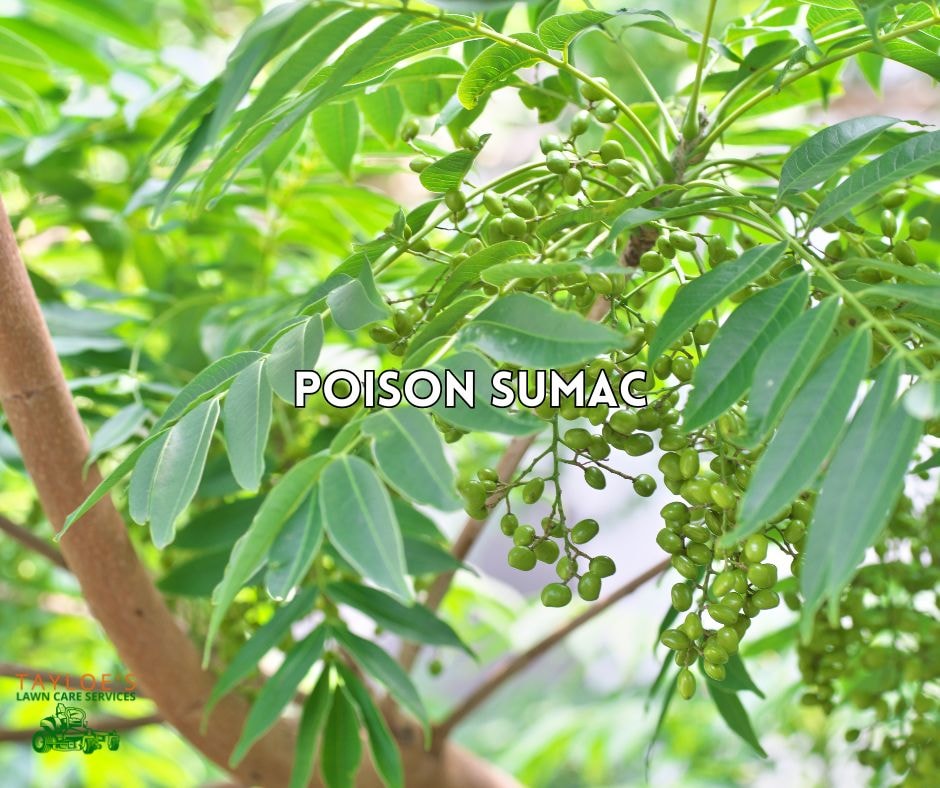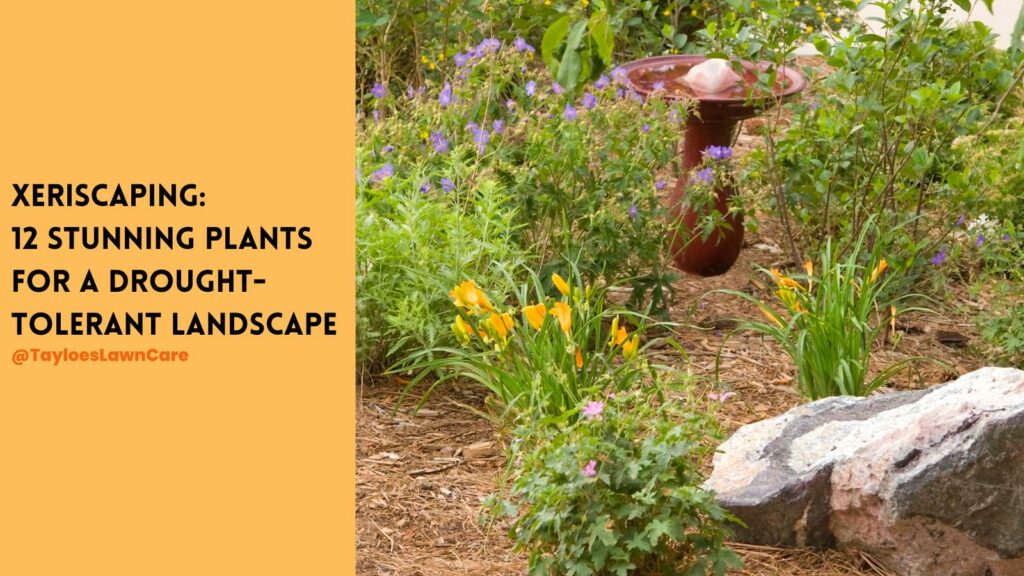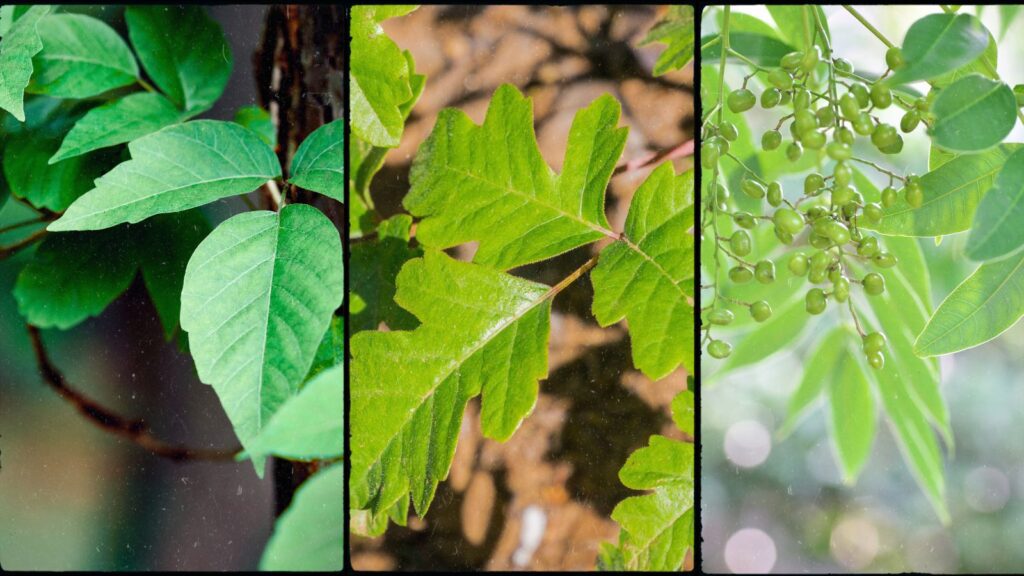
Avoiding poisonous plants to prevent the burning rash.
Poison ivy, poison oak, and poison sumac are common poisonous plants that can cause allergic reactions. These plants contain an oily resin called urushiol, which causes an itchy, blistering rash.
As lawn care specialists, one of the most common hazards we encounter are poisonous plants like poison ivy, poison oak, and poison sumac. These – and other poisonous plants – can cause an itchy, uncomfortable rash that can turn the next several days into a miserable experience.
In this article, we’ll help you identify these plants to avoid the rash, and we’ll discuss first aid tips. But when it comes to the first aid section, remember that we’re lawn care experts, not doctors. So always check with your physician if you suspect a severe reaction.
Identifying Poison Ivy Plants
Poison ivy is one of the most well-known poisonous plants. It typically has three glossy leaves, which can be smooth or slightly notched at the edges. The saying “Leaves of three, let it be” is a helpful reminder.
Poison Ivy Habitat
Poison ivy grows throughout the United States, except in Alaska or Hawaii. It’s particularly common along the edges of forests, trails, and roadsides here in North Carolina. The poison ivy plant can grow in almost all environments, from sunny open fields to shaded areas in the forest.
Variations of Poison Ivy Plant
You might see a poison ivy vine, often climbing trees or fences, or as a low shrub. The appearance can vary, making it tricky to identify.
Recognizing Poison Ivy Plant in Every Season
Spring: Poison ivy leaves are usually reddish during spring.
Summer: Leaves turn green and may have a glossy appearance.
Fall: The three leaflets can change to pale yellow, orange, or red.
Berries: Small, white, and can be another identifying feature.
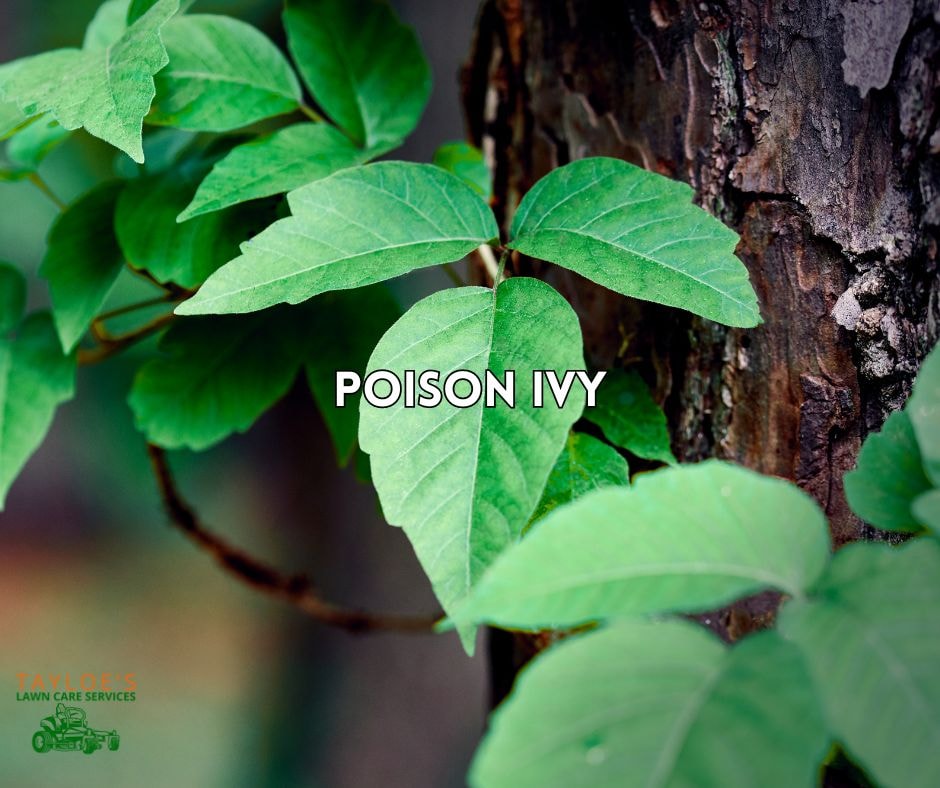
Identifying Poison Oak
Poison oak leaves resemble oak tree leaves, with rounded or lobed edges. They usually grow in three clusters leaves, similar to poison ivy, which can lead to confusion.
Poison Oak Habitat
Poison oak is common in the western United States, typically in dry, sunny areas. However, it can also be found in wooded areas and streams in the southeastern United States.
Variations of Poison Oak Plant
Poison oak can appear as a shrub or a vine. It grows in dense thickets, making it easy to brush up against.
Identifying Seasonal Variations
Leaves: Green in spring and summer, they turn yellow or red in the fall.
Berries: Greenish-white clusters that can help in identification.
Stems: Often covered in fine hair.
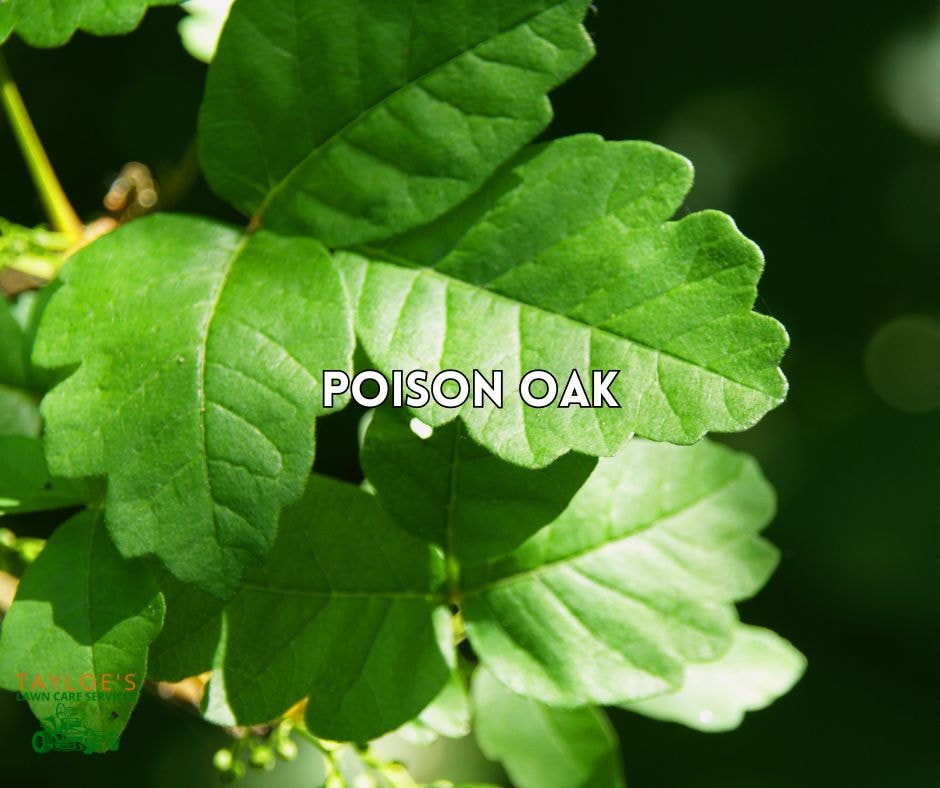
Identifying Poison Sumac
Poison sumac is less common than poison ivy and poison oak in our area. However, it can be more toxic. It features 7-13 leaflets arranged in pairs with a single leaflet with slightly rounded tips at the end.
Poison Sumac Plant Habitat
Poison sumac prefers wet, swampy areas, especially in the eastern and southern United States. It can grow in standing water or very moist soil, and it is common in bogs and wetlands.
Variations of the Poison Sumac Plant
Poison sumac grows as a tall shrub or small tree, reaching up to 20 feet in height.
Seasonal Changes in Poison Sumac Leaves and Plants
Leaves: Smooth-edged, with a glossy appearance and pointed tips and smooth edges.
Berries: Hang in loose clusters, turning from green to white berries as they mature.
Stems: Often red and smooth.

Virginia Creeper: Often Mistaken for a Poisonous Plant
Virginia Creeper (Parthenocissus quinquefolia) is a common native plant often mistaken for poison ivy or oak due to its similar growth habits and appearance. Unlike poison ivy, which has clusters of three leaves, Virginia Creeper typically has five leaflets.
The leaves are usually toothed and can range from green to reddish. While Virginia Creeper can’t cause a poison ivy rash, it can still cause mild skin irritation in some in. Recognizing the difference between them is key to avoiding unnecessary worry and ensuring proper identification and handling of poisonous species.
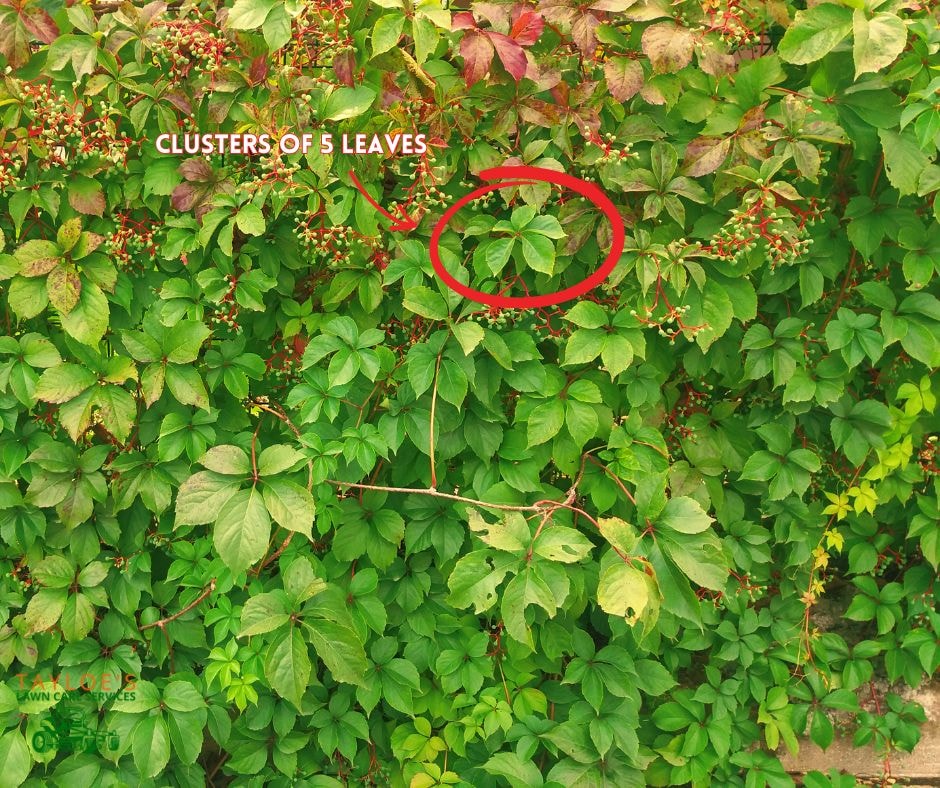
Recognizing the Itchy Rash After Contact With a Poisonous Plant
The itchy rash spreads in all three of these poisonous plants is due to a plant oil called urushiol, which causes an allergic reaction called contact dermatitis. Common symptoms of a poison ivy rash include:
Redness
Itching
Swelling
Blisters that may weep fluid
The rash typically appears a few hours to two days after contact with the plant and the allergic reaction can last from one to two weeks.
The severity of the rash depends on individual sensitivity and the amount of urushiol that comes into contact with the skin. Some people might experience a mild case of contact dermatitis, while others could suffer more intensely.
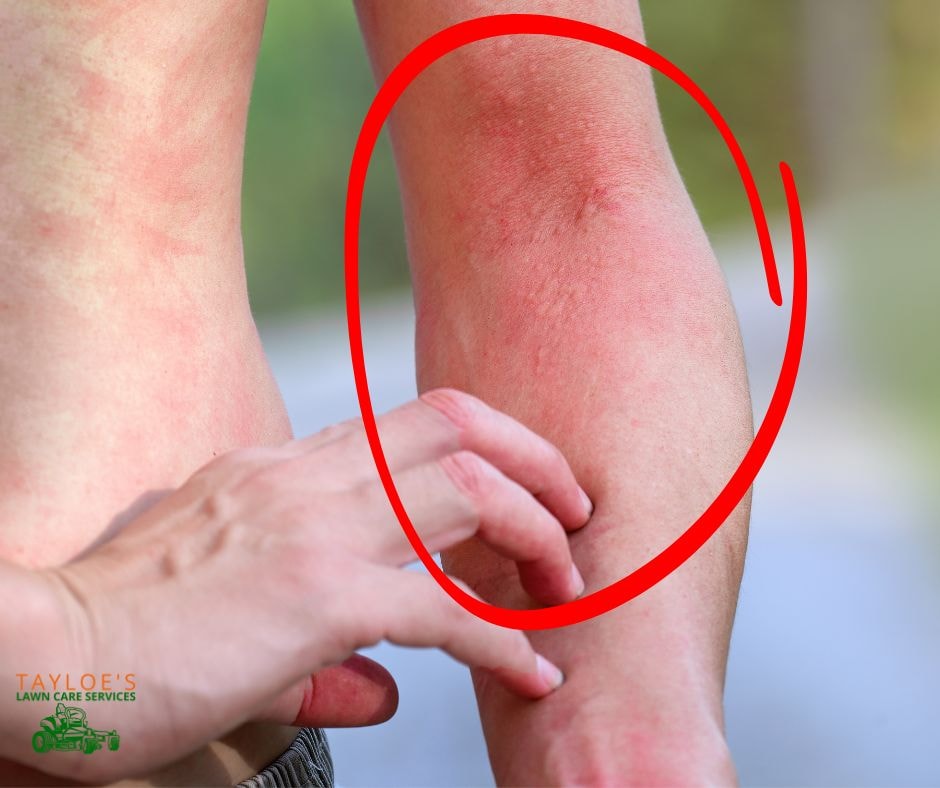
First Aid for Poison Ivy, Oak, and Sumac
If you suspect contact with poison ivy, oak, or sumac, it’s crucial to act quickly:
Wash the affected area: Use soap and cold water as soon as possible to remove the plant oil.
Avoid scratching: Scratching can cause the rash to spread and may lead to infection.
Home Remedies for
Several home remedies can help alleviate the discomfort:
Cool compresses: Applying cool, wet compresses can help soothe itching.
Calamine lotion: This over-the-counter lotion can relieve itching and dry out blisters.
Hydrocortisone cream: A mild steroid cream that can reduce inflammation and itching.
Antihistamines: Oral antihistamines like diphenhydramine (Benadryl) can help reduce itching, especially at night.
Baking soda paste: Apply this paste to the affected area to temporarily relieve the itchiness. It can be messy, so wrap a towel around it.
Colloidal oatmeal: Adding colloidal oatmeal to your bath can relieve itching and irritation. This natural remedy has soothing and anti-inflammatory properties to help calm the skin.
Aluminum acetate: Ask your pharmacist if aluminum acetate might be helpful – it is an astringent they may keep behind the pharmacy counter.
When to See a Doctor for a Poison Ivy Rash
It’s essential to seek medical attention if:
The rash is widespread or severe.
You have difficulty breathing. Breathing problems could indicate more severe reactions than typical or damage to the nasal passages or throat.
Your rash appears to have an infection. Look for increased redness, pus, or fever.
The rash involves sensitive areas like the face, eyes, or genitals.
Disclaimer: We Cut Grass, We’re Not Physicians
As experienced lawn care specialists, we’ve had our fair share of itchy encounters with these plants. However, I must remind you that we’re lawn care experts, not medical professionals. If you suspect you’ve encountered these plants and developed a rash, it’s always best to check with your family physician. Our advice comes from years of firsthand itchy experience, not medical school!
Tips for Handling Poisonous Plants
Dealing with poisonous plants like poison ivy, poison oak, and poison sumac requires careful handling to avoid contact with the irritating urushiol oil. Sure, you want to avoid these and other plants that can cause rashes. But when you see those three leaflets in your yard, you’ll want to get rid of it.
Here are some essential tips to keep in mind when handling species that contain urushiol oil:
Burning Poison Ivy, Oak, or Sumac Is a No-Go
Never burn poison ivy, poison oak, or any poisonous plant. Burning poison ivy, oak, or sumac releases urushiol particles into the air. Once airborne, the plant oil can cause severe respiratory issues after inhaling smoke. Always dispose of these plants by bagging them and disposing of them safely.
Wear Protective Clothing
Wear long sleeves and long pants to minimize skin exposure when working where these plants might be present. This protective clothing acts as a barrier, reducing the risk of the oil coming into contact with your skin.
Clean Your Garden Tools or Contaminated Objects
Urushiol can remain active on surfaces for a long time. Clean your garden tools, gloves, and any other contaminated objects thoroughly with soap and water or rubbing alcohol to prevent future exposure.
Don Rubber Gloves and Throw Them Out After Handling Poisonous Plants
Always wear rubber gloves when handling or removing these plants. Once you’re done, dispose of the gloves immediately to avoid accidental contact with urushiol.
Remember to Bathe Your Pet’s Fur if They Came into Contact
Pet fur can carry urushiol if it comes into contact with these plants. Bathe your pets thoroughly to remove any traces of the oil and prevent it from spreading to your skin or other surfaces in your home.
By following these tips, you can protect yourself and others from the uncomfortable urushiol oil rash for the next few weeks.
The Takeaway: Outsmarting Poison Ivy, Oak, and Poison Sumac Means Educating Yourself
Identifying poison ivy, oak, and sumac can save you from discomfort. Knowing what to look for and where these plants are typically found can help you take preventive measures. If you do end up with a rash, remember our first aid tips, but don’t hesitate to consult your doctor if necessary.
Stay vigilant while enjoying your yard, and don’t forget to subscribe for more tips and tricks on maintaining a healthy, rash-free lawn and garden. Feel free to share your experiences or ask questions on Facebook or by calling us at 252.287.3376.
Happy gardening, and may your encounters with poison ivy, oak, and sumac be few and far between!
Author Profile

- Deborah Tayloe is the CEO and co-founder of Tayloe's Lawn Care Services, LLC. She has a B.S.Ed and holds certificates in soil and water management and herbology from accredited programs.
Latest entries
 GardeningSeptember 27, 2025What perennials, shrubs, and trees don’t like fall pruning (and why)?
GardeningSeptember 27, 2025What perennials, shrubs, and trees don’t like fall pruning (and why)? Trees and ShrubsSeptember 14, 2025Fall Shrub Pruning Guide (September–October)
Trees and ShrubsSeptember 14, 2025Fall Shrub Pruning Guide (September–October) Trees and ShrubsApril 22, 2025Boxwood Blight: Early identification and isolation
Trees and ShrubsApril 22, 2025Boxwood Blight: Early identification and isolation Flower GardenApril 8, 2025John F. Kennedy Rose: Hybrid tea rose with elegant white blooms
Flower GardenApril 8, 2025John F. Kennedy Rose: Hybrid tea rose with elegant white blooms

